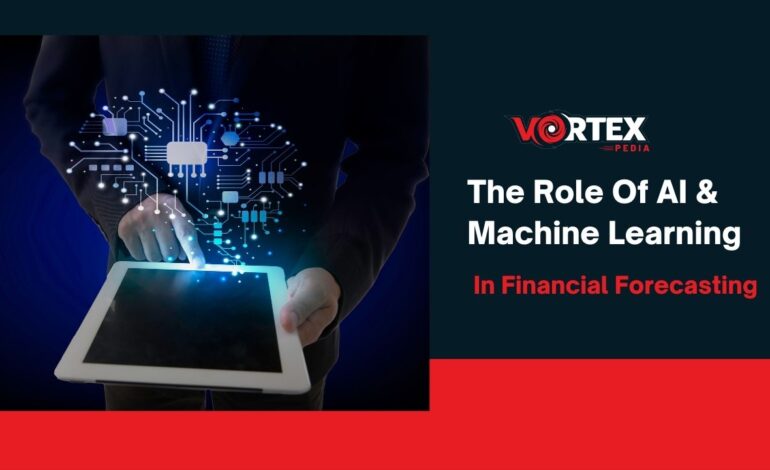
The Role Of AI & Machine Learning In Financial Forecasting
The use of Artificial Intelligence and Machine learning in the current world has transformed how financial forecasting is done. This paper presents the effects of AI and ML technologies on financial forecasting procedures, advantages, disadvantages, and trends.
Introduction
Budgeting is the foundation of strategic management in organizations, and the forecasting of financial data is considered to be the key to achieving it. Manually, forecasting was mainly based on past data and statistics in an attempt to foresee future trends. However, the application of AI and ML features new and advanced methods of processing large datasets, finding intricate relationships, and providing better estimates.
Understanding AI & Machine Learning In Financial Forecasting
AI is the science wherein an endeavor is made to reproduce human intelligence in machines that can be able to learn and reason like human beings. Learning from the experience is accomplished by the use of ML which is a subcategory of AI. When it comes to business and finance, they aid in the prediction of general trends and fluctuations of stock and various other things.
Market & Analysis
AI adopts news, social media, and market data which inform the investors’ attitudes and probable market shifts. Sentiment analysis is useful in determining the views that people hold especially concerning the financial markets.
Risk Management
Based on past data and the current environment, predictions about the different risk aspects are made by the embedded ML models. Such an approach allows for the effective protection of many risks and the rational use of funds in financial institutions.
Algorithmic Trading
Trading robots conduct transactions under specific set parameters and immediate market conditions. These algorithms reach for opportunities quickly and dynamically adapt them.
Fraud Detection
AI identifies cases of irregularity in financial transactions that characterize fraud. Machine learning algorithms are trained from past experiences with a view of improving the accuracy in identifying fraudulent transactions as well as reducing the cases of false positives
Benefits Of AI & Machine Learning In Financial Forecasting
Enhanced Accuracy
Thus, Beyond merely filtering data at a faster pace than human analysts it also spots trends in the billions of entries that human brains will not notice.
Speed & Efficiency
Some of the functions impacted by artificial intelligence include the collection of information, processing of information, and reporting of information that influences the turnaround time of the forecasts.
Adaptability To Changing Conditions
Machine learning models are dynamic these models are ‘trained’ to learn challenging conditions in the market improve predictions in real-time and offer suitable solutions to the experts in the finance domain.
Cost Efficiency
When sometimes used in forecasting processes, AI assists in the cutting down of operational costs that would have otherwise been incurred during manual processes thus enhancing the provision of financial services.
Challenges & Considerations
Data & Quantity
The usage of AI as a tool is based on the capability to have and analyze data. With such data, the model that is developed will lead to poor and inaccurate predictions.
Interpretability
High levels of AI models may be considered as having poorly interpretable decisions therefore creating a challenge when it comes to auditing or verifying the results.
Regulatory Compliance
Banking and financial institutions need to be keen on the regulatory and legal requirements that AI systems have to meet in terms of data privacy, consumer protection, and algorithmic explainability.
Future Trends & Outlook
With the constant development of the technology and use of the power of data analysis, the future of AI and ML in financial forecasting looks very bright. Key trends include:
Explainable AI: The attempts at increasing the relevance of the AI models, as well as the further attempts at explaining these models.
Quantum Computing: Ability to perform higher degree calculations and thus reach better forecasts more quickly.
Ethical AI: Concentrate on the correct use of AI and dealing with prejudice in algorithm choices.
Conclusion
AI and particularly ML contribute to the enhancement of the efficiency of financial forecasting and decision-making. Despite issues like data quality and regulatory compliance that often arise, the revolution of this technology in the Financial Sector towards greater innovation and competition hence competitiveness cannot be doubted. AI and ML’s integration gives organizations opportunities to exploit the value of insights and cope with the growing sophistication of markets.
To sum it up, the implementation of AI and ML in financial forecasting is a groundbreaking step that enhances the performance of financial workers as well as provides them with figured tools for making decisions and minimizing the risk of negative revenue shifts in the context of the innovative worldwide economy. To get more information related to business and finance must visit vortexpedia.
FAQs
What are AI and machine learning in financial forecasting?
Machine learning and artificial intelligence are operations based on the use of algorithms, which search for, select, and interpret financial data, as well as solve specific tasks without being directly coded.
In what ways does AI enhance the predictability of financial figures?
AI improves forecasting since it analyzes big transactional data and complicated and unique patterns, and alters the forecast in real time.
What are the applications of AI and ML in financial forecasting?
Some of the applications are market aggregation, risk control, high-frequency trading, credit card scams, and customized banking.
What are the benefits of using AI in financial forecasting?
Advantages include enhanced accuracy as well as the speed of processing, better risk management reduction of costs as well as flexibility to changes in the market.
What are the challenges of implementing AI in financial forecasting?
Some of the problems of AI implementation are data quality, model interpretability, legal frameworks, and integration with relevant systems, and AI vulnerabilities to cyber threats.
In what ways can risk management be aided by the application of AI and ML?
They help to reveal risk indicators and tendencies in the past, forecast changes in prices, and strengthen the methods of risk evaluation and management.
What are the trends of AI and ML in forecasting the future in the area of finance?
Future trends in forecasting include the growth in xAI, quantum computing, and more concern for ethical AI to spur innovation.
What should organizations do in preparation for integrating AI into the process of financial forecasting?
It consists of building an appropriate infrastructure for data processing, introducing AI and analytics concepts, developing proper guidelines, involving outside AI specialists, and constant models’ fine-tuning.








